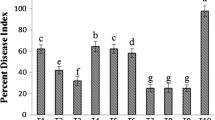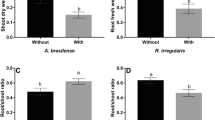Abstract
Biocontrol agents (Pseudomonas aeruginosa HB-15 and Pantoea sp. HB-22, alone or in combination) were applied on cucumber (Cucumis sativus L.) plants to evaluate their effect on suppressing damping-off caused by the fungal pathogen Rhizoctonia solani. Plant biomass, percent root mortality, phosphorus uptake, and the levels of stress-indicators NH3-NH4 + and proline in the plants were measured following the treatments. Additionally, gene expression induced by the biocontrol agents was compared to the gene expression induced by jasmonic acid and salicylic acid treatments. The biocontrol treatments increased fresh weight and phosphorus uptake, and reduced root mortality of the cucumber plants inoculated with the pathogen. No differences in plant ecophysiological responses were detected among biocontrol agent treatments. Concentrations of NH3-NH4 + and proline in the leaves and roots were higher in the control than in the biocontrol treatments. Salicylic acid- and Pantoea sp. HB-22-treated cucumbers showed increased expression of the acidic peroxidase-encoding gene and the phenylalanine ammonia homologue, while the P. aeruginosa HB-15 treatment did not induce an increase in expression of any of the genes studied.
Similar content being viewed by others
Literature Cited
Agrios GN (1997) Plant Pathology, Ed 4, Academic Press, San Diego, USA
Baker R (1990) An overview of current and future strategies and models for biological control. In D Hornby, ed, Biological Control of Soilborne Plant Pathogens, CAB International, London, UK, pp 375–388
Bates LS, Waldren RP, Teare ID (1973) Rapid determination of free proline for water-stress studies. Plant Soil 39:205–207
Burkhead KD, Schisler DA, Slininger PJ (1994) Pyrrolnitrin production by biological control agent Pseudomonas cepacia B37w in culture and in colonized wounds of potatoes. Appl Environ Microbiol 60:2031–2039
Cools HJ, Ishii H (2002) Pre-treatment of cucumber plants with acibenzolar-S-methyl systemically primes a phenylalanine ammonia lyase gene (PAL1) for enhanced expression upon attack with a pathogenic fungus. Physiol Mol Plant Pathol 6:273–280
Dong X (1998) SA, JA, ethylene, and disease resistance in plants. Curr Opin Plant Biol 1:316–323
Hwangbo H (2006) Biocontrol of Plant Diseases by Phosphate Dolublizing Bacteria, PhD dissertation, Chonnam National University Publisher, Gwangju, Republic of Korea
Kloepper JW, Beauchamp CJ (1992) A review of issues related to measuring colonization of plant roots by bacteria. Can J Microbiol 38:1219–1232
Lazacano-Ferrat I, Lovat CJ (1999) Relationship between relative water content, nitrogen pools, and growth of Phaseolus vulgaris L. and P. acutifolius A. Gray during water deficit. Crop Sci 39:467–475
Liu L, Kloepper JW, Tuzun S (1995) Induction of systemic resistance in cucumber against Fusarium wilt by plant growth promoting rhizobacteria: Duration of protection and effect of host resistance on protection and root colonization. Phytopathology 85:1064–1068
Maurhofer M, Reimmann C, Schmidli-Sacherer P, Heeb S, Haas D, Défago G (1998) Salicylic acid biosynthetic genes expressed in Pseudomonas fluorescens strain P3 improve the induction of systemic resistance in tobacco against tobacco necrosis virus. Phytopathology 88:678–684
Meyer SLF, Roberts DP (2002) Combinations of biocontrol agents for management of plant-parasitic nematodes and soilborne plant-pathogenic fungi. J Nematol 34:1–8
Penninckx IA, Eggermont K, Terras FR, Thomma BP, De Samblanx GW, Buchala A, Métraux JP, Manners JM, Broekaert WF (1996) Pathogen-induced systemic activation of a plant defensin gene in Arabidopsis follows a salicylic acid-independent pathway. Plant Cell 8:2309–2323
Raupach GS, Kloepper JW (1998) Mixtures of plant growth-promoting rhizobacteria enhance biological control of multiple cucumber pathogens. Phytopathology 88:1158–1164
Roberts DP, Lohrke SM, Meyer SLF, Buyer JS, Bowers JH, Baker CJ, Li W, De Souza JT, Lewis JA, Chung S (2005) Biocontrol agents applied individually and in combination for suppression of soilborne diseases of cucumber. Crop Prot 24:141–155
Shanahan P, O'Sullivan DJ, Simpson P, Glennon JD, O'Gara F (1992) Isolation of 2,4-diacetylphloroglucinol from a fluorescent Pseudomonad and investigation of physiological parameters influencing its production. Appl Environ Microbiol 58:353–358
Singh CP, Mishra MM, Yadav KS (1980) Solubilization of insoluble phosphate by thermophilic fungi. Annals de Microbiologie 131B:289–296
Stockwell VO, Johnson KB, Sugar D, Loper JE (2002) Antibiosis contributes to biological control of fire blight by Pantoea agglomerans strain Eh252 in orchards. Phytopathology 92:1202–1209
Thomashow LS, Weller DM (1988) Role of a phenazine antibiotic from Pseudomonas fluorescens in biological control of Gaeumannomyces graminis var. tritici. J Bacteriol 170:3499–3508
Yang J, Kloepper JW, Ryu CM (2009) Rhizosphere bacteria help plants tolerate abiotic stress. Trends Plant Sci 14:1–4
Author information
Authors and Affiliations
Corresponding author
Rights and permissions
About this article
Cite this article
Hwangbo, H., Kim, KY. & Choi, HS. Effects of biocontrol agents on suppression of damping-off in Cucumis sativus L. caused by Rhizoctonia solani . Hortic. Environ. Biotechnol. 57, 191–196 (2016). https://doi.org/10.1007/s13580-016-0163-0
Received:
Revised:
Accepted:
Published:
Issue Date:
DOI: https://doi.org/10.1007/s13580-016-0163-0




